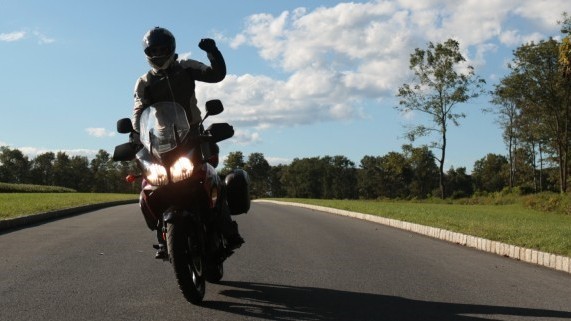This article originally appeared on the American sport Touring Website and is reposted here with permission from the author.
Time to shake off that winter chill and get ready to ride! Don’t wait to get yourself and your motorcycle in shape for the season ahead. Sure, winter weather forced most riders to put the bike away and take up other passions, but that was then and now a new season begins.
Here’s a list of pre-season tips that are equally good for the bike, the body, and the mind.
Inspect for Obvious Prpblems
A careful visual safety inspection is a simple but important step before heading out for that early spring ride. All the checks described here are straightforward and don’t require tools. Start with these, and if anything looks amiss take the bike to a qualified mechanic for a deeper inspection and to perform scheduled service, all of which is listed in your owner’s manual. Your owner’s manual is an excellent guide to maintain a safe and reliable motorcycle.
The best way to start a visual inspection is by giving the motorcycle a thorough washing. When no longer covered by winter dust, or worse last year’s road dirt, spotting issues becomes much easier.
Important checks that almost anyone can do.
Check The Tires
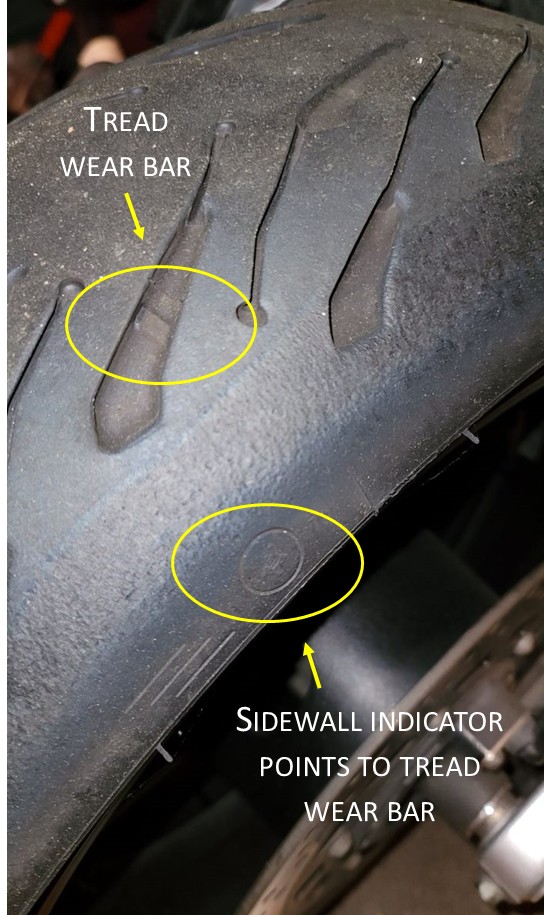
First look at the motorcycle tire wear bars. Then look the tire over for cracks or cuts in the sidewalls or tread area. Check that tread depth at the center is above the wear bars built into the tire tread pattern, indicating a depth of at least 2/32 of an inch. If the tread is close or flush with the bar it’s time for new rubber. Also take time to look for uneven tread wear which often indicates a suspension alignment problem. And lastly, don’t forget to check tire pressures and re-inflate them to proper levels, (see Find the Best Tire Pressure for Your Motorcycle).
Beyond tires, inspect the wheels as well for any significant scrapes or road damage that could cause handling problems or allow the tire to unseat.
Look for Worn Brake Pads and Rotors Like tires, brake pads have built-in wear indicators that can be seen at the edge of the pad between the brake caliper and rotor. If a groove is not visible or barely visible, it means there’s less than 2mm of brake lining left. Put more directly, it’s time to replace the pads.
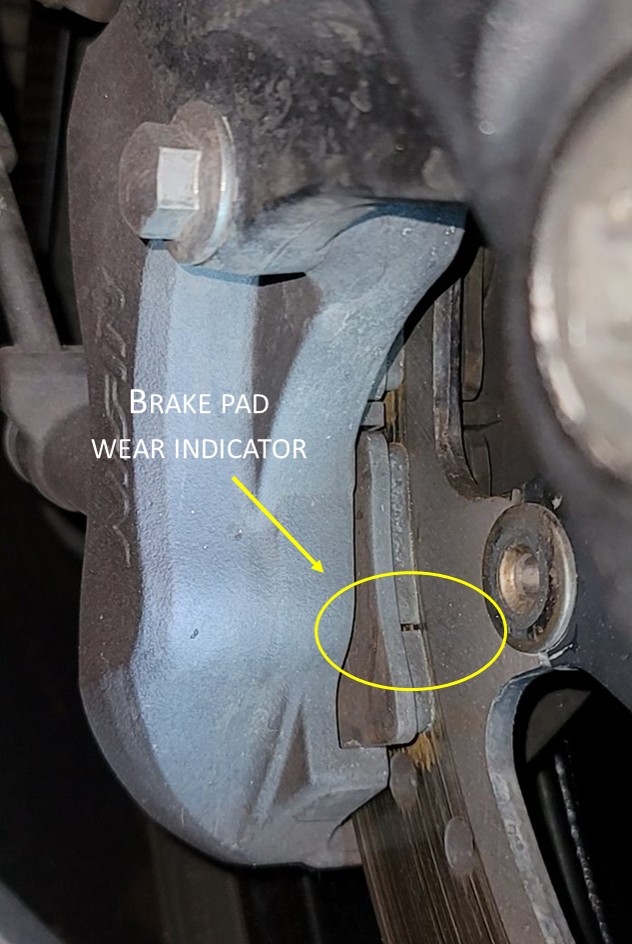
Brake rotors don’t have convenient built-in wear indicators. Instead, look for a lip or ridge at the outer edge of the rotor beyond the brake pad contact surface. If the ridge is a millimeter (1mm) or more the rotor is at the end of its useful life and should be replaced. Likewise, replacement is in order if the rotor surface itself shows visible grooves or scoring. Rotor cracks and warping can be an issue but are rare and hard to spot. If this is a concern, ask a mechanic to take a closer look.
Make Sure All Lights Are Working Take a minute to make sure head lights, taillights and turn signals are all working. Visually check the headlights, including high and low beams. Turn on the turn signals and check front and rear. Have a friend pull the brake lever to confirm the brake light works and then do it again with the pedal. Check any after-market lights too, such as driving lights. Don’t forget to look for cracked or damaged lenses that can allow water intrusion that may damage the light housing.
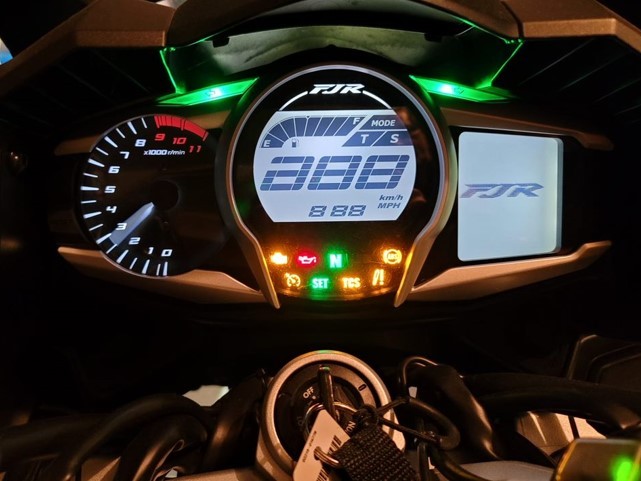
Check The Instrument Panel Double check that all gauges and warning lights are working correctly. The owner’s manual will describe how to do this. In most cases warning lights illuminate when the ignition is switched on and then go off after a few seconds. Some warning lights stay on until the motorcycle reaches a certain speed, for example ABS or traction control indicators. Analog gauges, such as the tachometer, rotate through their range as well to show they are working. If an indicator or gauge fails to operate, have the system checked by a qualified mechanic. Don’t forget to check that the instrument panel backlighting (helpful at night or in tunnels) works too.
Look for Fluid Leaks in around the engine casing. Engine casings, cover seams, and fittings should be free of oil; although, with age some seeping may occur. Fluid leaks are sometimes obvious and other times hidden and hard to spot. Leaks around exposed engine covers are easy to inspect. Ideally, the seams between parts are clean and oil-free. But don’t worry about a little seeping. That’s common and not a real concern. On the other hand, if the surface is wet and oily consider asking a qualified mechanic to have a look.
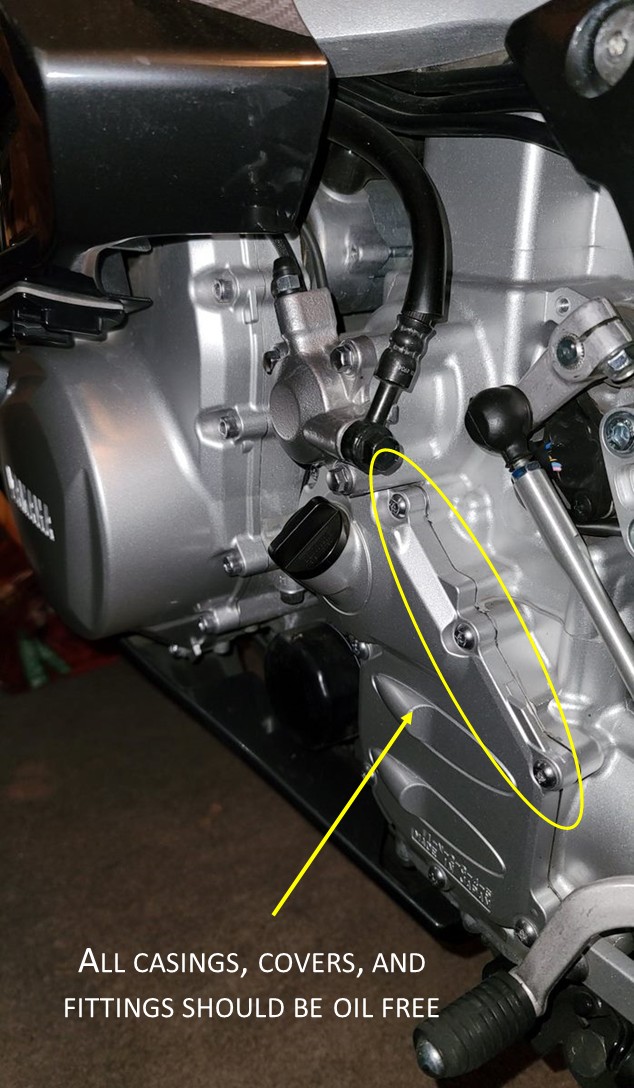
Inspect the brake and clutch master cylinder housings for any leaks or oozing as well. Check the clutch line and brake line fittings and then follow them to where they connect with the brake caliper or clutch release mechanism looking for any worn or brittle spots. Again, any discernable fluid leaks or worn hoses should trigger a visit to the shop.
Low radiator coolant and coolant leaks are harder to check given the reservoir, radiator, and hoses are usually all tucked up in front of the engine and behind the fairings. Use a flashlight to peak in, try removing fairing panels, or if all else fails seek professional help for this otherwise simple task.
Inspect the Bodywork. Make sure fairings are properly attached, fenders are secure, and mirror mounts seated correctly. Plastic mounting clips and screws can rattle lose over time. Also take a minute to check that side case bracket mounts are tight and side cases latch on securely. Do the same for any after-market luggage mounts, such as a tail bag or tank bag.
Perform Scheduled Maintenance
Moving beyond the visual inspections described so far, it’s time to actually do some maintenance.
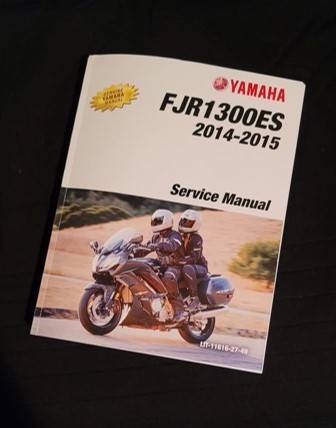
Performing regular motorcycle checks, adjustments, and services according to manufacturer recommendations are the most effective way to ensure long-term reliable operation and avoid more costly service work down the line. Service recommendations are well described in the owner’s manual. However, an official shop service manual contains a great deal more information including how to perform regular maintenance tasks. But be warned – manufacturer service manuals are expensive, for example Yamaha charges $99 for the 2021 FJR Service Manual.
While some service procedures are straightforward, others like adjusting valve clearance are best done by a trained technician. Recognizing that, we recommend having a professional mechanic perform factory scheduled service. A competent mechanic will get the job done quickly and correctly leaving you to enjoy riding with greater confidence.
The following are recommended maintenance procedures to perform at the beginning of the riding season:
Oil and filter change.
Engine tune up, including spark plugs, fuel filter, fuel injectors, and air filter.
Inspect brake and clutch fluid levels and lines, replace lines that show cracks or with leaky fittings, top-up fluids, bleed the system if levels were extremely low.
Check the battery and charging system.
Lubricate the drive system, Clean and lubricate the chain, or on shaft drive motorcycles check the final gear oil and replace at the recommended service interval.
Lubricate all bearings, including swing arm, suspension pivot points, and steering and fork.
Rely on your owner’s manual or shop manual, for a list of recommended inspections and service procedures. Performing service at the scheduled odometer reading may be time consuming and costly, but the effort pays off in confidence and peace of mind.
Check Your Riding Gear
To start with, simply try everything on to make sure it all fits correctly. Jackets should be snug but not tight to allow plenty of upper body movement. Boots should have firm ankle protection, flexible forward movement, and of course no worn spots that could compromise weather protection. Same for gloves and pants, no weak points due to wear and no restricted movement.
Helmets are a special area of attention. Manufacturers recommend replacing helmets after 5 years of use. An older, well used helmet will begin to lose its fit as pads compress and breakdown. Look for a sticker with the date of manufacture under the padding, often above the left ear. Snell certified helmets will have an additional sticker indicating the Snell certification test year. A helmet that has suffered a hard drop or worse been in a crash, should be replaced regardless of its age. Keep in mind that not all damage is visible. A dropped helmet may have hidden cracks that can weaken the shell and reduce the effectiveness of the helmet when it matters most.
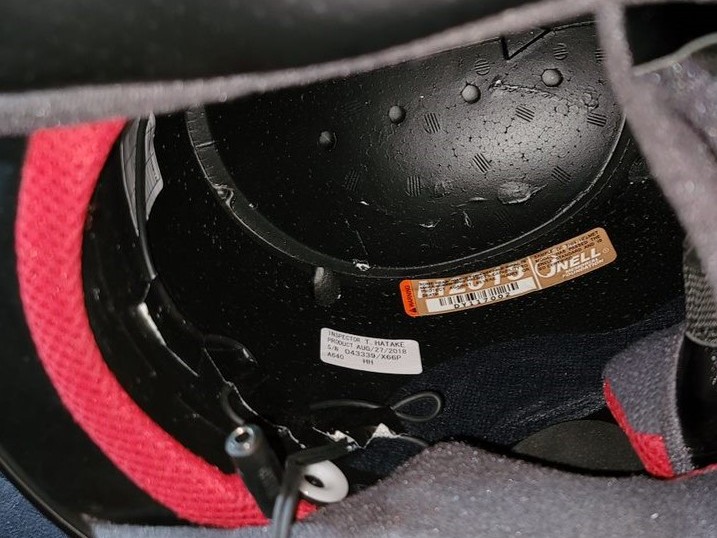
Polish-up Those Riding Skills
Getting mentally and physically fit is at least as important as preparing your motorcycle. For Sport Touring riders, motorcycling demands agility, flexibility, and stamina. It’s not too late to start training even if the benefits come later in the season. Look for a few ideas in the article Ride Fit Ride Better. Get started with a short re-acquaintance ride. Good riding instincts and habits come back fast, but may need a little stimulation to reawaken. So gas up and ride for a few hours, looking for as many different scenarios as possible to practice the basics. If after a couple hours things don’t feel right, make a note to focus on those areas of concern the next time out. It may take more than one ride to feel as good at the start of the season as you did at the end of the last.
While on one of those warm-up rides, pay special attention to how the bike accelerates, shifts, corners, and stops. If anything seems amiss have a qualified motorcycle mechanic take a look.
That’s it. The essentials are in order. All that’s left is to plan where to ride and what to see.
Let the rising season begin!
